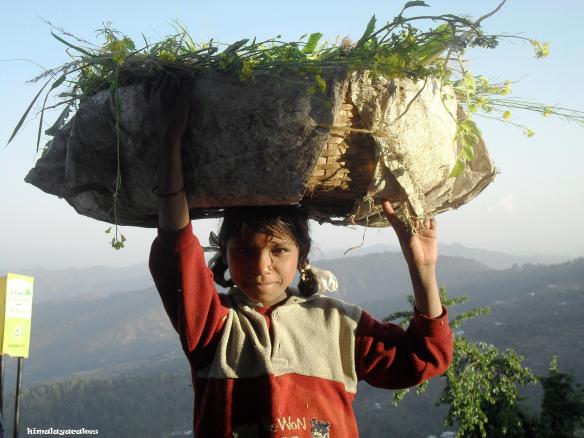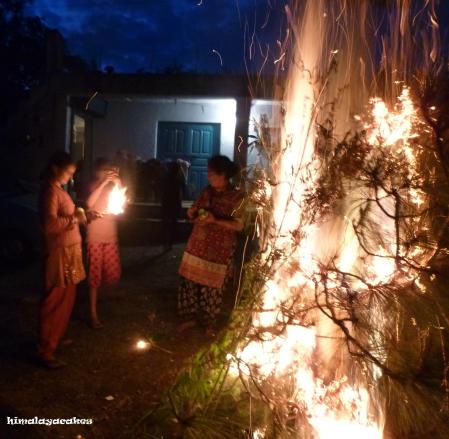September 2015
Every year in September it’s officially “Grass-Cutting-Season” A beautiful and cheerful time up here in the Himalayas.
First of all, the women of the surrounding area gather for a grass-cutting-council. They organize who will help to cut whose grass on which land. The grass prices are extensively discussed and eventually settled.
Some may wonder why there is so much fuss about something as trivial as grass. Up here we are talking about a very valuable natural product. The mountain side is dry and barren during the winter months and every family has to make sure that there will be enough hay available for their cows, buffaloes and goats.
Soon after all the organizing part is clear, the ladies set themselves to work. In the steep hillside no machines can be used. Crouching on the ground to cut grass by hand with a sickle and then transport a huge bundle of it on the head is a very hard job. On top of it the women also climb high on trees to hang the grass there to dry. Nature turns into a big barn and whenever pasture is needed in the winter, they go back to the trees to take of the necessary amount.
When I first saw women sometimes double my age carrying the heavy load on their head up the hill, I was torn between a feeling of pity and deepest admiration. Women here are amazingly strong in all senses! To be honest, most of the time I already struggle with my own body weight when I walk up the mountain; (don’t tell anyone!). My feeling of pity soon dissolved, as I realized that all of them, no matter how young or old, are really looking forward to the grass-cutting-season and indeed enjoy it a lot! It actually seems to be some kind of women’s circle, where they charge themselves with the energy of Mother Nature. It’s a time to teach, learn, chat, gossip, and exchange grass-cutting-stories not only during a well deserved Thermos chai break; stories about babies being born on the field, snakes and leopards. They are rightly proud of how high and good they can climb and of how much weight they are able to carry.
When they come back from a day of work, they look tired, but happy with a lot of hay in their beautiful black hair. When I meet them, they always ask me seriously, but half laughing (…an Indian thing…) to come along with them with my sickle. Before I didn’t get very much the Indian sense of humor and replied with excuses like not having land, cows, sickle, time or whatever. Now I just answer that I’ll be there in a minute with my tool; sometimes I say so ten times a day.
I love to observe the women working in the fields. Sometimes even in the form of colorful spots through a curtain of rain. Instead of going home, they cover themselves with a piece of plastic to keep themselves dry and keep on cutting. But the same season also turns me sad somehow, as the landscape turns from green into brown and Grey again. I also found out that it somehow affects my mood.
It probably has to do with the general change which comes along with fall and the slowly inwards turning energies.
Mid September here marks also the beginning of the cold season. Last week the corresponding ritual took place: On the night in question, women light a big fire in front of their homes and feed it with some cannabis branches as an offering (by the way, the cutting of this “grass” happens in October) and share a cucumber as prasad (blessed food).
In their prayer they ask the coming winter not to be too much cold and cruel. From that moment on the cold season has been officially declared, accepted and who knows, maybe even invited. At least I don’t really understand how they do it; but every year right the next day after the ritual there is a major drop in temperature, frequently accompanied by cold rain.
IT’S LIKE MAGIC!




